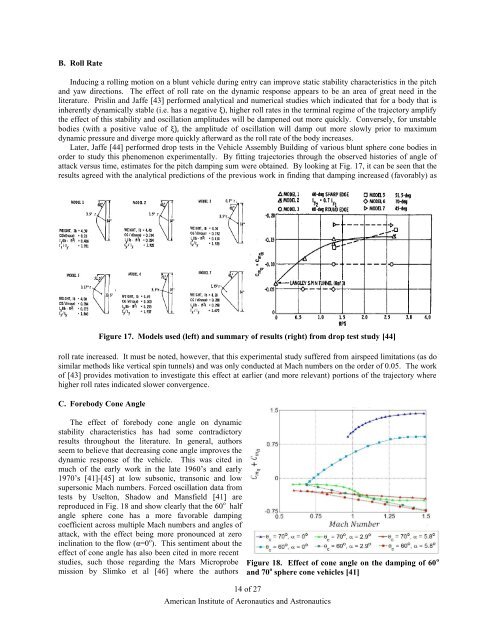Survey of Blunt Body Dynamic Stability in Supersonic Flow
Survey of Blunt Body Dynamic Stability in Supersonic Flow
Survey of Blunt Body Dynamic Stability in Supersonic Flow
Create successful ePaper yourself
Turn your PDF publications into a flip-book with our unique Google optimized e-Paper software.
B. Roll Rate<br />
Induc<strong>in</strong>g a roll<strong>in</strong>g motion on a blunt vehicle dur<strong>in</strong>g entry can improve static stability characteristics <strong>in</strong> the pitch<br />
and yaw directions. The effect <strong>of</strong> roll rate on the dynamic response appears to be an area <strong>of</strong> great need <strong>in</strong> the<br />
literature. Prisl<strong>in</strong> and Jaffe [43] performed analytical and numerical studies which <strong>in</strong>dicated that for a body that is<br />
<strong>in</strong>herently dynamically stable (i.e. has a negative ξ), higher roll rates <strong>in</strong> the term<strong>in</strong>al regime <strong>of</strong> the trajectory amplify<br />
the effect <strong>of</strong> this stability and oscillation amplitudes will be dampened out more quickly. Conversely, for unstable<br />
bodies (with a positive value <strong>of</strong> ξ), the amplitude <strong>of</strong> oscillation will damp out more slowly prior to maximum<br />
dynamic pressure and diverge more quickly afterward as the roll rate <strong>of</strong> the body <strong>in</strong>creases.<br />
Later, Jaffe [44] performed drop tests <strong>in</strong> the Vehicle Assembly Build<strong>in</strong>g <strong>of</strong> various blunt sphere cone bodies <strong>in</strong><br />
order to study this phenomenon experimentally. By fitt<strong>in</strong>g trajectories through the observed histories <strong>of</strong> angle <strong>of</strong><br />
attack versus time, estimates for the pitch damp<strong>in</strong>g sum were obta<strong>in</strong>ed. By look<strong>in</strong>g at Fig. 17, it can be seen that the<br />
results agreed with the analytical predictions <strong>of</strong> the previous work <strong>in</strong> f<strong>in</strong>d<strong>in</strong>g that damp<strong>in</strong>g <strong>in</strong>creased (favorably) as<br />
Figure 17. Models used (left) and summary <strong>of</strong> results (right) from drop test study [44]<br />
roll rate <strong>in</strong>creased. It must be noted, however, that this experimental study suffered from airspeed limitations (as do<br />
similar methods like vertical sp<strong>in</strong> tunnels) and was only conducted at Mach numbers on the order <strong>of</strong> 0.05. The work<br />
<strong>of</strong> [43] provides motivation to <strong>in</strong>vestigate this effect at earlier (and more relevant) portions <strong>of</strong> the trajectory where<br />
higher roll rates <strong>in</strong>dicated slower convergence.<br />
C. Forebody Cone Angle<br />
The effect <strong>of</strong> forebody cone angle on dynamic<br />
stability characteristics has had some contradictory<br />
results throughout the literature. In general, authors<br />
seem to believe that decreas<strong>in</strong>g cone angle improves the<br />
dynamic response <strong>of</strong> the vehicle. This was cited <strong>in</strong><br />
much <strong>of</strong> the early work <strong>in</strong> the late 1960’s and early<br />
1970’s [41]-[45] at low subsonic, transonic and low<br />
supersonic Mach numbers. Forced oscillation data from<br />
tests by Uselton, Shadow and Mansfield [41] are<br />
reproduced <strong>in</strong> Fig. 18 and show clearly that the 60 o half<br />
angle sphere cone has a more favorable damp<strong>in</strong>g<br />
coefficient across multiple Mach numbers and angles <strong>of</strong><br />
attack, with the effect be<strong>in</strong>g more pronounced at zero<br />
<strong>in</strong>cl<strong>in</strong>ation to the flow (α=0 o ). This sentiment about the<br />
effect <strong>of</strong> cone angle has also been cited <strong>in</strong> more recent<br />
studies, such those regard<strong>in</strong>g the Mars Microprobe<br />
mission by Slimko et al [46] where the authors<br />
Figure 18. Effect <strong>of</strong> cone angle on the damp<strong>in</strong>g <strong>of</strong> 60 o<br />
and 70 o sphere cone vehicles [41]<br />
14 <strong>of</strong> 27<br />
American Institute <strong>of</strong> Aeronautics and Astronautics
















